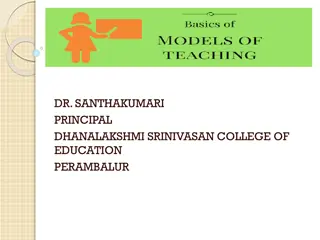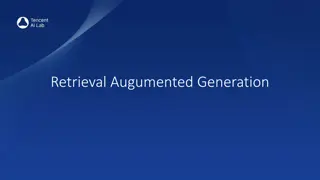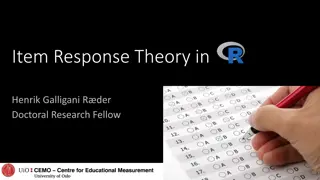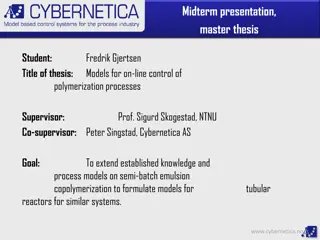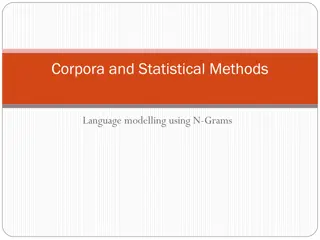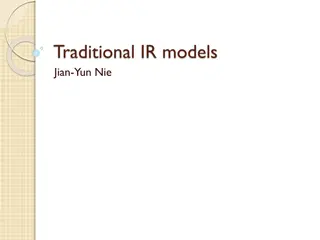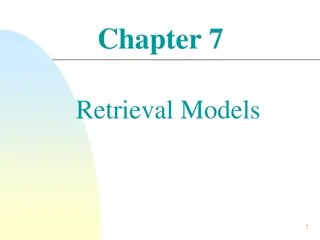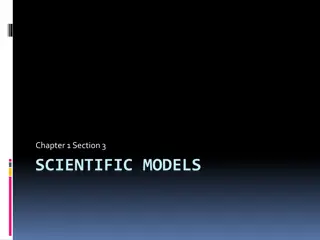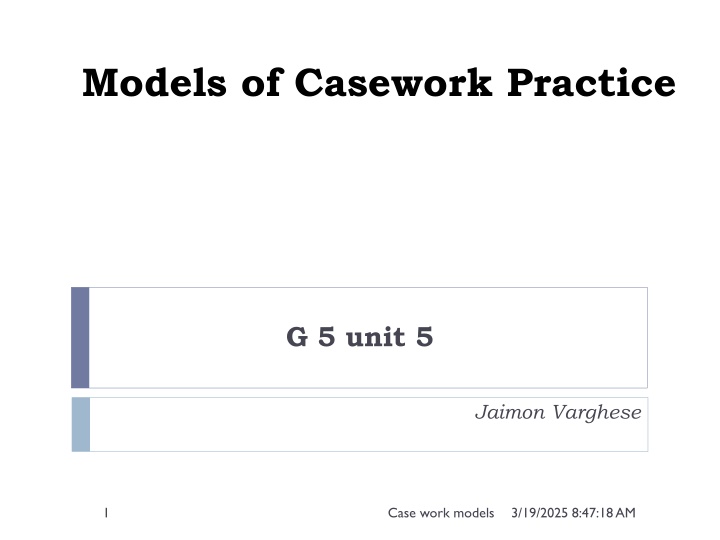
Casework Practice Models: Social Diagnostic, Supportive & More
Explore various models of casework practice including Social Diagnostic by Mary Richmond and Supportive & Modificatory by Hamilton. Learn how these models help in diagnosing and supporting individuals for better social functioning through effective techniques.
Download Presentation

Please find below an Image/Link to download the presentation.
The content on the website is provided AS IS for your information and personal use only. It may not be sold, licensed, or shared on other websites without obtaining consent from the author. If you encounter any issues during the download, it is possible that the publisher has removed the file from their server.
You are allowed to download the files provided on this website for personal or commercial use, subject to the condition that they are used lawfully. All files are the property of their respective owners.
The content on the website is provided AS IS for your information and personal use only. It may not be sold, licensed, or shared on other websites without obtaining consent from the author.
E N D
Presentation Transcript
Models of Casework Practice G 5 unit 5 Jaimon Varghese 1 Case work models 3/19/2025 8:47:18 AM
5. Models of Casework Practice a. Social diagnostic (Richmond) b. Supportive and modificatory (Hamilton) c. Problem solving (Perlman) d. Crisis intervention (Rappaport) e. Classified treatment method (Florence Hollies) f. Competence based approach (Elleen Grabrill) 2 Case work models 3/19/2025 8:47:18 AM
Social Diagnostic Model (Richmond) This model is provided by Mary Richmond Direct (psychological) and Indirect (environmental modification) help Man is a social animal. A person behaves in accordance with his/her environment. We cannot ignore the social environment. Therefore, certain problem may arise due to the environment in a person s life. 3 Case work models 3/19/2025 8:47:18 AM
To effectively handle such problem and help the person for better social functioning, we need to diagnose the problem in a proper way. We need to see or find out the problem in the context of the problematic situation or the social environment. We need a social diagnosis of the problem (in contrast to psychological or clinical diagnosis) We have to gather information and different opinions by the collateral contacts. 4 Case work models 3/19/2025 8:47:18 AM
Supportive and modificatory (Hamilton) man always seeks social support : administrative (leadership) and executive support Why s/he needs support? 1. Because he never believes completely in himself. 2. Secondly, he is not aware of his capacities & abilities 3. Thirdly, s/he does not like to fight against the situation alone 4. Fourthly, s/he does not know how to fight 5. Fifthly, he strongly believes in having a company or a group. 5 Case work models 3/19/2025 8:47:18 AM
Therefore, lack of faith in herself/himself deteriorates the self-confidence and s/he tries to be happy and content with the existing situation. S/he does not show courage to change it Therefore, in Social Case Work, the client needs the case worker s support to modify the situation As a caseworker, s/he should use the supportive technique to help out the individual in different ways. 6 Case work models 3/19/2025 8:47:18 AM
The supportive techniques (unit 6) are Acceptance, Assurance, Allaying feelings that are overpowering Accrediting and building of Self-Confidence , Encouragement and Reassurance, Being With the Client , Action- Oriented Support and Advocacy That support will help him/her to fight with the situation. the caseworker should also focus on the environment (external/internal) of the client and modify it if needed. 7 Case work models 3/19/2025 8:47:18 AM
Problem solving (Perlman) The case work process is a progressive transaction between the professional help (the caseworker) and the client. It consists of a series of problem-solving operations carried on within a meaningful relationship. The end of this process is to so influence the client person that he develops effectiveness in coping with this problem and / or to so influence the problem as to resolve it or vitiate its effects (Helen Harris Perlman, 1957:5). 8 Case work models 3/19/2025 8:47:18 AM
All competent problem solving, as contrasted with trial and error method, contains three essential operations. (i) The facts that constitute and bear upon the problem must be ascertained and grasped. Such facts may be of objective reality and of subjective reaction. (ii) The facts must be thought about. The facts must be played upon and organised by ideas springing from knowledge and experience and subject to the governing aim of problem resolution. 9 Case work models 3/19/2025 8:47:18 AM
(iii) Some choice or decision must be made, that is, the end result of the consideration of the particular facts, and that affects or has the intent of resolving the problem. Such a decision may take the form of the selection of a course of overt action or more subtly of some change in the person s responsive relationship to the problem. Either conclusion must be tested for its validity by some action upon the problems by some different attack upon it or by some changed internal or overt behaviour in relation to it. 10 Case work models 3/19/2025 8:47:18 AM
Finally, for the solution of mitigation of many problems, there must exist certain material means of accessible opportunities which are available to the needful and which he can be helped to use. Money, medical care, nursery schools, scholarships, foster homes, recreation facilities these are the kinds of resources that any person may need in order to resolve given problem in his daily living 11 Case work models 3/19/2025 8:47:18 AM
Crisis Intervention (Rappaport) Crisis is a form of disaster in human life. Disaster brings stress, problem and difficult situations. If we find a individual in crisis, we should not intervene immediately. As a human, s/he has their own self dignity and courage to fight their problem. Interference by the caseworker should be done with kind allowance by the client. 12 Case work models 3/19/2025 8:47:18 AM
In the crisis intervention model of case work, the client is given enough time to struggle himself or herself attempting to get through the problem Once all the known ways and means are exhausted the client approaches the case worker for solution to the problem The case worker may show new ways and means to continue the struggle by the client Once all the options are tried at the level of the client the case worker intervenes 13 Case work models 3/19/2025 8:47:18 AM
The case worker will try to modify the factors that are beyond the control of the client (environmental modification and networking) Finally the client get through the problem by the crisis intervention by the case worker Throughout the struggle, the case worker provides assurance and reassurance The ultimate objective of this approach is enhancing to the client s capacity for crisis management in future 14 Case work models 3/19/2025 8:47:18 AM
Classified treatment method (Florence Hollies) A client may encounter different problems at a time. So as a caseworker, we should know to classify the problems according to their nature Focusing on the immediate problem we should not underestimate other related problems. There is a need for prioritizing the problem According to this model, we should provide specific treatment to the client according to nature of his /her problems. 15 Case work models 3/19/2025 8:47:18 AM
Psychological problems may be classified with the help of diagnostic statistical manual Social problems may be classified into economic, domestic (family related), occupational (work related), situational (contextual / neighbourhood), interpersonal There are different procedure to solve each of the problems identified There are several factors or combination of factors significant to each problem solving process 16 Case work models 3/19/2025 8:47:18 AM
Florence Hollies Classification Environmental pressure reduction model Environmental modification Indirect impact: material help, institutional help, network assistance Psychological stress alleviation model Psychological support Clarification Insight building Direct impact: research, describe, discuss, modelling, development model, communication (Taksale, 2004:201)* *Taksale Prajakta (2004) Vyaktisahakarya Part II, Nagpur: Shree Ganesh Prakashan 17 Case work models 3/19/2025 8:47:18 AM
Competence based approach (Strength based Approach) - Elleen Grabrill Each and every individual has their own strength and weakness. They have their own expertise and skills This approach suggests that every individual has own strength which often go unnoticed and unappreciated This approach recognize the inherent strengths of individual that are significant in helping process 18 Case work models 3/19/2025 8:47:18 AM
Focusing primarily on the problem may reinforce negative views that the client may have about themselves Instead of discussing too much on the weakness and failures of the client, this approach dictates building on clients strength to create positive change When peoples positive capacities are supported their scope for growth is shown Finally the clients develops competence to deal with stressful situations in future on their own. 19 Case work models 3/19/2025 8:47:18 AM
Thank You 20 Case work models 3/19/2025 8:47:18 AM




